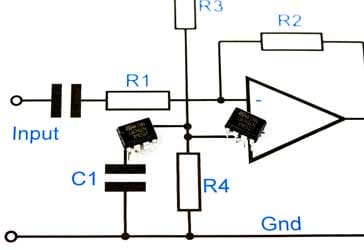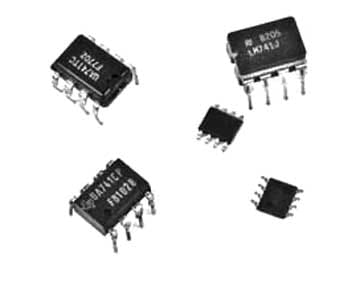How to Choose the Right Op Amp
When designing a circuit, it is important to select the right op amp for the particular application as some are general purpose, others offer low noise, others high input impedance, etc
Op-amp Tutorial Includes:
Introduction
Op amp gain
Bandwidth
Op amp slew rate
Offset null
Input impedance
Output impedance
Current feedback op amp
Understanding specifications
How to choose an op amp
Op amp circuits summary
 Check out my Op-Amp eBook. Check out my Op-Amp eBook. |
When selecting an op amp for any given project there are a number of choices to be made. Some op amps are general purpose ones and suit many general purpose applications, whereas other op amps have been designed with higher levels of performance in some areas.
When undertaking any electronic circuit design using op amps, it is necessary to select the right type to ensure that the best performance is obtained for the best cost, as well as taking other factors like the electronic component distributor or supplier, and lead time, etc into consideration as well.
In many circuits the standard general purpose op-amps will perform very well and the higher performance levels of specialist op amps will not be needed, but in some applications enhanced performance is required and the more specialist op amps can be chosen.

Op amp requirements
The ideal op amp, should it ever exist, would have infinite gain, infinite input impedance, zero output impedance, it should have an infinite frequency response, not introduce any noise, and it should be distortion free. Obviously no op amp can meet all these requirements.
However when selecting the right op amp there is a balance to be made between the different op amps. General purpose ones will perform adequately in most areas, whereas, some others may have a very high input impedance, or low noise, or wide frequency response.
When designing an op amp circuit, it is necessary to know what is required, so that the best op amp for the job can be chosen.
General purpose op-amp
When selecting the electronic components for a circuit design, it is necessary to look at what is needed and not to increase the specification any further than is needed.
Increasing the requirements for the performance of the operational amplifier, or any other electronic components may increase not only the cost, but it may restrict the number of suppliers and also mean that it it is not as easy to source.
There are many general purpose operational amplifiers that are available, often with second sources. If these can be selected, then cost, and availability are made much easier.
That said, if a higher performance operational amplifier is needed, then the higher performance electronic component will need to be selected.
High input impedance
In some applications a very high input impedance op amp may be required. A number of instances may arise where a very much higher impedance is required than that normally available on a general purpose op amp. On example may be for the electronic circuit design of an integrator. When the charge is integrated over a long period of time, even the high impedance of a standard op amp will be noticed as charge will leak away.
There may also be instances where high impedance probes are used, and an op amp placed very close to the probe as a buffer to prevent stay pick-up. Here a high impedance op amp may be needed. There are also many other applications where high impedance op amps may be required.
In instances like these op amps with FET inputs may need to be selected. These op amps present exceedingly high levels of impedance at the input. A current path for biasing the input still needs to be incorporated as the FETs need to be properly biased, but even so these FET input op amps provide an excellent choice.
Low noise
Another parameter of importance in some applications is the noise. Where the circuits demand a good noise performance it is necessary to choose a low noise op amp. These devices are readily available as there are many areas where selecting a low noise device is important.
Noise can be particularly important in the input stages of a product. Further stages of amplification will only amplify the noise and it cannot be removed.
If using the op amp for an input stage, then it may well be advisable to choose a low noise op amp.
Low power / current
With many items requiring to be battery powered these days, low power consumption can be an issue. Many op amps have been designed for these applications, and by searching, it is possible to choose some very low power op amps.
Low supply voltage
Early op amps used to run from supplies that might be ±15V. Nowadays with many circuits needing to run from much lower supplies these voltages are not practicable in many instances. Fortunately it is possible to choose low voltage op amps.
Choosing the right op amp package
When choosing an op amp, it is also necessary to select the package type. The chips can be obtained in a variety of different packages, both conventional though hole mounting in 4 and 8 pin dual in line as well as a variety of surface mount packages as well.

Also don’t forget that it is possible to select packages with multiple op amps within them. Typically they can come with two and four op amps per package, although higher counts are available. These can save space on the board and cost . When opting for the higher number op amps per package, remember these multiple devices per package do not normally come with offset null connections. Check this before choosing the device if offset null is required.
Electronic components distributor / supplier choice
When buying an operational amplifier it may not just be a case of getting the product at the cheapest price. Buying from an electronics component distributor may be a necessity in some instances.
Especially for commercial organisations where electronic manufacture is undertaken, there may be other issues to consider and the choice of electronic component distributor is more crucial.
Timescales: It is often necessary to consider the timescales when selecting who to buy capacitors and other electronic components from. Some electronic component distributors may be able to deliver very quickly or on a required date. and this is an advantage in many instances. Having the right product when it is required can mean that the amount of inventory held on the electronics manufacturing site can be reduced.
Also having the electronic components reliably scheduled to arrive when they are needed can reduce the difficulties of handling shortages in the manufacturing process.
It often occurs that as global electronic equipment starts to increase, then lead times increase considerably. Under these circumstances, having an electronic component distributor as a partner can provide considerable assistance in obtaining the required inventory.
- Cost: Cost is a major consideration when buying electronic components. Particularly for private individuals this may be one of the most important considerations. Normally quality is good, but this needs to be taken into account especially when prices are low. Normally though quality is very good.
- Wide availability: In some instances a wide availability of stock is needed and this may be a reason for selecting a particular electronic components distributor or stockist.
- Ship to stock: For large scale electronics manufacturing, it is possible to set up a facility known as ship to stock. By entering relationship with an electronic components distributor, they can be aware of the requirements and when stock runs low at the production facility, then new components can be shipped directly into the production line within minimum of formality.
Traceable stock: For many professional applications it is necessary to have electronic components, and in this case operational amplifiers that are from a guaranteed source and not counterfeit. If counterfeit stock entered the supply chain then it could have an impact on performance, reliability and a number of other factors.
In addition to this, there can be penalties of stock is shown to be counterfeit, particularly when manufacturing equipment for many government organisations. Using an established, authorised electronic components distributor can ensure that the stock is obtained from the correct sources.
For most manufacturing situations, electronic component distributors will be used, but for hobbyists and for some small scale prototyping applications, components from regular electronic component sources may often use used.
Choosing an op-amp that matches the needs of any given application, first needs the requirements to be understood. Once this has been done, the requirements can be compared to the devices that are available and the best choice of op amp can be made.
Short circuiting the process is likely to mean that the wrong device is chosen. Following a logical approach means that the right op amp is chosen to meet the needs for the circuit in question.
 Written by Ian Poole .
Written by Ian Poole .
Experienced electronics engineer and author.
Essential operational amplifier data:-
Make your op-amp selection with op-amp data as well as distributor price and availability.
Check it out now!
More Circuits & Circuit Design:
Op Amp basics
Op Amp circuits
Power supply circuits
Transistor design
Transistor Darlington
Transistor circuits
FET circuits
Circuit symbols
Return to Circuit Design menu . . .



